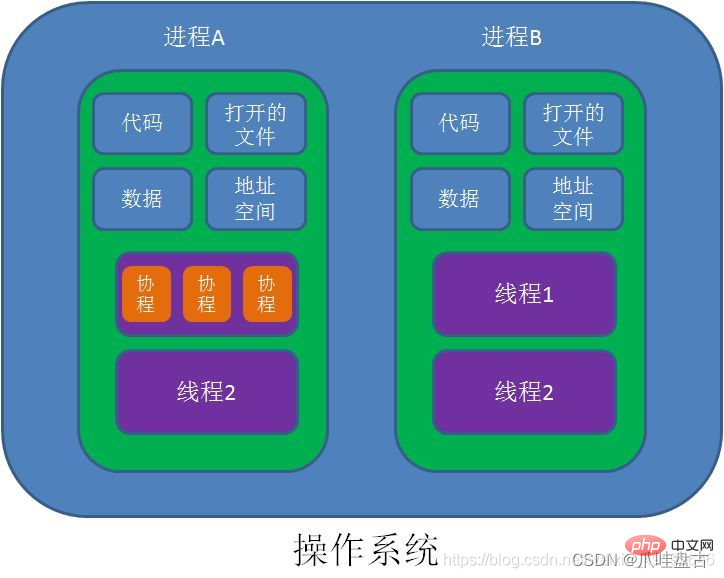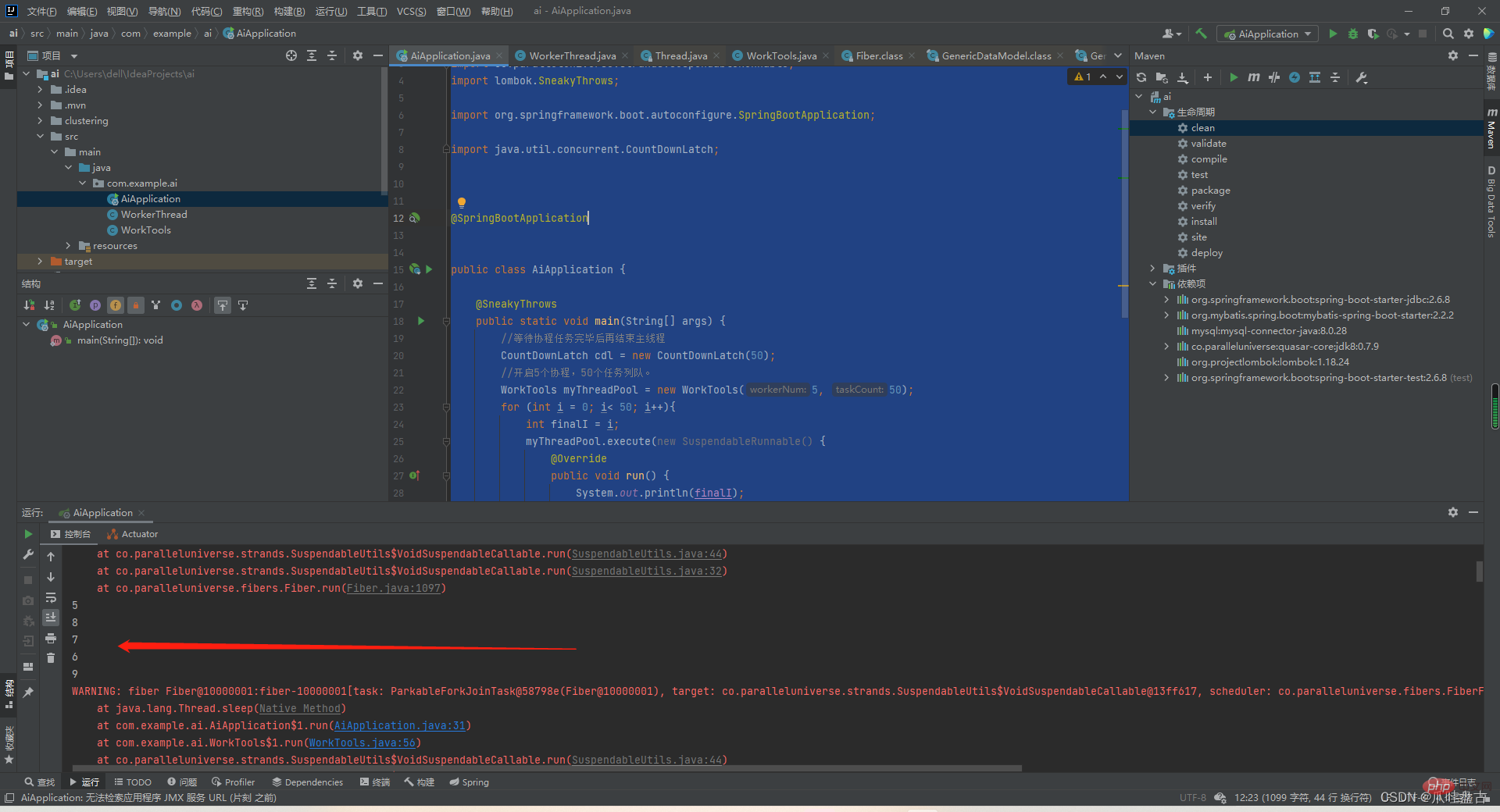範例介紹Java基於quasar實現協程池
2022-06-27 14:01:30

推薦學習:《》
業務場景:golang與swoole都擁抱了協程,在同任務並行數量下,協程可比執行緒多幾倍。所以最近在查詢java時瞭解java本身是沒有協程的,但是某牛自行實現了協程,也就是本文的主角quasar(纖程)!不過沒看到誰公開一下手寫協程池的騷操作(誰會直接new它用?那是沒捱過社會的毒打呀~)
一個執行緒可以多個協程,一個程序也可以單獨擁有多個協程。
執行緒程序都是同步機制,而協程則是非同步。
協程能保留上一次呼叫時的狀態,每次過程重入時,就相當於進入上一次呼叫的狀態。
執行緒是搶佔式,而協程是非搶佔式的,所以需要使用者自己釋放使用權來切換到其他協程,因此同一時間其實只有一個協程擁有執行權,相當於單執行緒的能力。
協程並不是取代執行緒, 而且抽象於執行緒之上, 執行緒是被分割的CPU資源, 協程是組織好的程式碼流程, 協程需要執行緒來承載執行, 執行緒是協程的資源, 但協程不會直接使用執行緒, 協程直接利用的是執行器(Interceptor), 執行器可以關聯任意執行緒或執行緒池, 可以使當前執行緒, UI執行緒, 或新建新程.。
執行緒是協程的資源。協程通過Interceptor來間接使用執行緒這個資源。

廢話不多說,直接上程式碼:
匯入包:
<dependency>
<groupId>co.paralleluniverse</groupId>
<artifactId>quasar-core</artifactId>
<version>0.7.9</version>
<classifier>jdk8</classifier>
</dependency>WorkTools工具類:
package com.example.ai;
import co.paralleluniverse.fibers.Fiber;
import co.paralleluniverse.fibers.SuspendExecution;
import co.paralleluniverse.strands.SuspendableRunnable;
import java.util.concurrent.ArrayBlockingQueue;
public class WorkTools {
//協程池中預設協程的個數為5
private static int WORK_NUM = 5;
//佇列預設任務為100
private static int TASK_COUNT = 100;
//工做協程陣列
private Fiber[] workThreads;
//等待佇列
private final ArrayBlockingQueue<SuspendableRunnable> taskQueue;
//使用者在構造這個協程池時,但願啟動的協程數
private final int workerNum;
//構造方法:建立具備預設協程個數的協程池
public WorkTools() {
this(WORK_NUM,TASK_COUNT);
}
//建立協程池,workNum為協程池中工做協程的個數
public WorkTools(int workerNum, int taskCount) {
if (workerNum <= 0) {
workerNum = WORK_NUM;
}
if (taskCount <= 0) {
taskCount = TASK_COUNT;
}
this.workerNum = workerNum;
taskQueue = new ArrayBlockingQueue(taskCount);
workThreads = new Fiber[workerNum];
for (int i = 0; i < workerNum; i++) {
int finalI = i;
workThreads[i] = new Fiber<>(new SuspendableRunnable() {
@Override
public void run() throws SuspendExecution, InterruptedException {
SuspendableRunnable runnable = null;
while (true){
try{
//取任務,沒有則阻塞。
runnable = taskQueue.take();
}catch (Exception e){
System.out.println(e.getMessage());
}
//存在任務則執行。
if(runnable != null){
runnable.run();
}
runnable = null;
}
}
}); //new一個工做協程
workThreads[i].start(); //啟動工做協程
}
Runtime.getRuntime().availableProcessors();
}
//執行任務,其實就是把任務加入任務佇列,何時執行由協程池管理器決定
public void execute(SuspendableRunnable task) {
try {
taskQueue.put(task); //put:阻塞介面的插入
} catch (Exception e) {
// TODO: handle exception
System.out.println("阻塞");
}
}
//銷燬協程池,該方法保證全部任務都完成的狀況下才銷燬全部協程,不然等待任務完成再銷燬
public void destory() {
//工做協程中止工做,且置為null
System.out.println("ready close thread...");
for (int i = 0; i < workerNum; i++) {
workThreads[i] = null; //help gc
}
taskQueue.clear(); //清空等待佇列
}
//覆蓋toString方法,返回協程資訊:工做協程個數和已完成任務個數
@Override
public String toString() {
return "WorkThread number:" + workerNum + " ==分割線== wait task number:" + taskQueue.size();
}
}測試程式碼:
package com.example.ai;
import co.paralleluniverse.strands.SuspendableRunnable;
import lombok.SneakyThrows;
import org.springframework.boot.autoconfigure.SpringBootApplication;
import java.util.concurrent.CountDownLatch;
@SpringBootApplication
public class AiApplication {
@SneakyThrows
public static void main(String[] args) {
//等待協程任務完畢後再結束主執行緒
CountDownLatch cdl = new CountDownLatch(50);
//開啟5個協程,50個任務列隊。
WorkTools myThreadPool = new WorkTools(5, 50);
for (int i = 0; i< 50; i++){
int finalI = i;
myThreadPool.execute(new SuspendableRunnable() {
@Override
public void run() {
System.out.println(finalI);
try {
//延遲1秒
Thread.sleep(1000);
cdl.countDown();
} catch (InterruptedException e) {
System.out.println("阻塞中");
}
}
});
}
//阻塞
cdl.await();
}
}
具體程式碼都有註釋了,自行了解。我也是以執行緒池寫法實現。
當前為解決問題:在協程阻塞過程中Fiber類會報阻塞警告,滿臉懵逼啊,看著很討厭。暫時沒有辦法處理,看各位大神誰有招下方評論提供給下思路。萬分感謝~
推薦學習:《》
以上就是範例介紹Java基於quasar實現協程池的詳細內容,更多請關注TW511.COM其它相關文章!